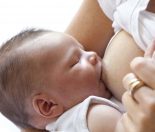This article on baby’s first breast feed gives parents encouragement, information and tips for the first breast feed you give your newborn baby.
Great benefits of breastfeeding
Of the 129 million babies born each year in the world, only approximately 10 million are born in countries where the mother may choose not to breastfeed her infant.
In fact until the last century there were no readily available options to breast milk and virtually all human infants received human milk.
Breast milk is superior in 2 ways –
Firstly, it completely meets the needs of the infants for the first 6 months of life.
Secondly, it provides protection from disease and pathogens (bugs) during the first year of life.
Breast milk contains
- Proteins for growth, to provide protection, to carry vitamins and hormones. The major protein in breast milk is whey, which decreases as breastfeeding continues. The proteins used in formula milks are different in composition to the proteins in breast milk, so can cause allergic reactions.
- Breast milk contains carbohydrate for energy and the rapidly growing brain. It contains much higher levels of lactose than the milk of other mammals.
- Breast milk contains fat and the type of fatty acids will depend upon the diet the mother consumes. A fuller breast will produce milk that is low in fat content, an emptier breast will contain milk with a high fat content. Breast milk contains cholesterol, which is then believed to have a protective effect later in life, as breast fed individuals are found to be less likely to get coronary artery disease.
- Breast milk contains vitamins and minerals, with sufficient levels to make exclusive breast feeding ideal for the first 6 months of life.
Proteins, carbohydrates, fats and leucocytes all have different protective mechanisms against disease and bacteria.
Protection provided by breastfeeding
Acute conditions are less common in breastfed infants.
It is vital (although not often seen as ‘politically correct’) to acknowledge the following statistics –
- Middle ear infection is 5 times more likely
- Diarrhoeal diseases is 10 times more likely
- Respiratory diseases is 2 times more likely
- Urinary tract infections are 3 times more likely
– in babies who are fed with formula milk.
The rate of Sudden Infant Death Syndrome (SIDS) is remarkably lower in breastfed infants and this decreases further with every additional month of exclusive breastfeeding.
In addition to protecting babies from acute conditions, breastfeeding has a long lasting effect, reducing the risk of childhood cancers, diabetes and Coeliac’s disease.
Breast milk is also highly protective of allergies and allergic conditions, such as asthma, eczema and allergies to foods.
The production of breast milk is hormonally driven in 3 stages
In pregnancy the production of colostrums is stimulated by the pregnancy hormone, prolactin.
Around 70 hours after the birth, the milk will ‘come in’. This will happen irrespective of whether the mother is breast feeding, and irrespective of the type of birth the mother had. It is thought that stress, among other things such as abnormal hormone levels caused by a retained piece of placenta, can delay the milk coming in.
The maintenance of milk production is then controlled by the emptying of the breast.
The infant’s mouth and jaw are ideally suited to breastfeeding
- The chin is small and fit closely against the breast during a feed
- The nose is then free to breath during feeding
- The cheeks are chubby, preventing them collapsing in during a feed
- The tongue is big and sucks efficiently from the nipple
A baby that is placed on his mother’s abdomen, following a normal birth, left dry, skin to skin and uninterrupted, will watch his mother, suck his fingers and then crawl towards the nipple. After moving his head side to side he will latch on and suck at the breast.
Initiating that important first feed
- Mother and baby need to be safe and quiet and dry and warm
- Infant should be undisturbed on mother’s abdomen.
- Here we must all resist the temptation to weight the baby, dress the baby and interfere with the delicate physiological process that is helping the baby to breastfeed.
- The infant will be quiet and watchful, after an initial cry. This cry is a vital action which moves all the fluid from the baby’s lungs to the circulation, allowing the baby to breath in oxygen.
- The baby needs to be left uninterrupted for 1 hour. In fact, if mother and baby are separated, the infant will drop his heart rate and respiratory rate. The baby may appear to be resting, but is in fact in despair in response of to the separation from his mother.
- The baby will locate the mother’s nipple by smell, hence the importance of leaving mother and baby unwashed and undisturbed.
- The healthy, term newborn baby is capable of latching on himself!
Additional facts…
The type of birth the woman has had should make no difference to allowing this physiological process to occur…
The normal infant can be observed whilst skin to skin with mum and the mother can be cared for, observed and encouraged, without any need for baby to be moved from her abdomen.
Babies should be put skin to skin with mum within half an hour of birth and left there for a minimum of 1 hour, whilst mum is supported and encouraged. (An exception to this would be if mum had had a general anaesthetic, in which case baby should be placed skin to skin within half and hour of her becoming conscious).
During this time the hormone levels in mother and baby are high and they ‘fall in love’.
Research shows that where this is promoted, infant abandonment and abuse is significantly lower.
Useful articles
For information and advice on successfully Expressing your Milk visit our Kiwi Families article.
Breastfeeding Tips covers a range of information to help you achieve successful breastfeeding.





